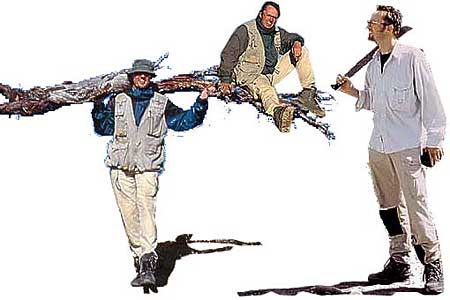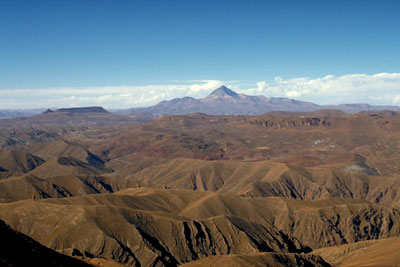

PROJECTS
-> Eastern Cordillera, Central Andes, Bolivia
-> 3D Restoration (Gocad)
-> 3D Projects (Gocad)
EASTERN CORDILLERA, CENTRAL ANDES, BOLIVIA

Kinematics
The Eastern Cordillera is a main morphotectonic unit of the Central Andes. In southern Bolivia it is predominantly composed of Ordovician sediments as thick as 10 km. Revision of the Ordovician stratigraphy and new structural fieldwork resulted in detailed balanced cross sections, improved estimates of crustal shortening and a new kinematic model for the Eastern Cordillera. Estimates of total shortening in the Eastern Cordillera are up to 95 km (41-44%), higher than previous estimates but still insufficient to thicken the crust to its present state.
 © Joachim Mueller
© Joachim MuellerAfter initial Tertiary uplift at about 58 Ma, first thrusts developed in the middle Eocene to early Oligocene (?40-?30 Ma), exhuming the central part of the Eastern Cordillera. Tectonic shortening culminated in late Oligocene and early Miocene time (25-20 Ma) when west-facing thrust systems developed in the central and western part of the Eastern Cordillera. Thrusting terminated in the western part by the end of the early Miocene and middle Miocene tectonic activity was restricted to minor strike-slip faulting. In the central part thrusting remained active until the Late Miocene. By about 10 Ma, shortening in the Eastern Cordillera essentially ceased.
Literatur
Müller, J.P ., Kley, J. & Jacobshagen, V. (2002): Structure and Cenozoic kinematics of the Eastern Cordillera, southern Bolivia (21°S).- Tectonics , 21(5), art.no.1037, doi:10.1029/2001TC001340.
Jacobshagen V., Müller, J.P ., Wemmer, K., Ahrendt, H. & Manutsoglu, E. (2002): Hercynian deformation and metamorphism in the Cordillera Oriental of Southern Bolivia, Central Andes.- Tectonophysics, 345(1-4): 119-130.
Kley, J., Müller, J. , Tawackoli, S., Jacobshagen, V. & Manutsoglu, E. (1997): Pre-Andean and Andean-age deformation in the Eastern Cordillera of southern Bolivia.- J. South Am. Earth Sci., 10: 1-19.
© Copyright 2001-2006, Joachim P. Müller. All rights reserved.
Reproduction or copying of images is prohibited.
Last update: 20.12.2005
Contact
Kinematic fault analyses indicate clockwise rotation of the shortening direction, from NNE-SSW or NE-SW in Eocene-early Oligocene time over E-W to WNW-ESE or even NW-SE in late Oligocene to middle Miocene time. Nevertheless, WNW-ESE-directed shortening and subvertical extension predominate. Sinistral oblique motion on many thrusts probably reflects plan view flexural slip in the clockwise rotating southern limb of the Bolivian orocline. Space problems in the oroclinal hinge slowed the rotation there and caused decoupling of the still rotating south limb along NE-trending transfer zones .